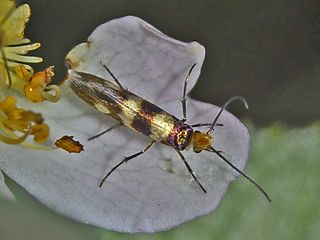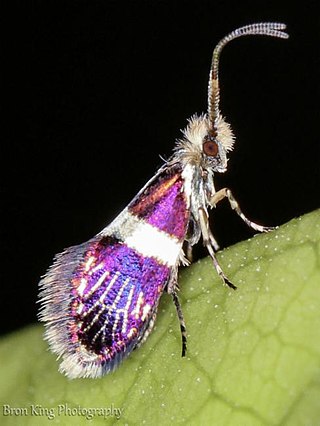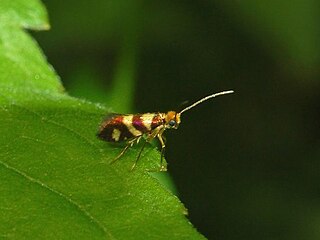
The mangrove robin is a passerine bird in the family Petroicidae. It is found in the Aru Islands, New Guinea, and northern Australia. The bird's common name refers to its natural habitat. They live in mangrove forests and seldom fly outside these biomes.
The 1911–16 Australian drought consisted of a series of droughts that affected various regions of Australia between the years of 1911 and 1916. Most of the dry spells during this period can be related to three El Niño events in 1911, 1913 and 1914, though rainfall deficiencies actually began in northern Australia before the first of these El Niños set in and did not ease in coastal districts of New South Wales until well after the last El Niño had firmly dissipated and trends toward very heavy rainfall developed in other areas of the continent.

Micropterix aruncella is a species of moth belonging to the family Micropterigidae, which is distributed throughout Europe. The imago was first described by Giovanni Antonio Scopoli in 1763. This species is one of the best known members of the family, being found in a wide range of habitats from sea level to over 2,000 metres (6,600 ft); the only habitat not favoured by this species is dense woodland.

Micropterix tunbergella is a moth of the family Micropterigidae found in most of Europe. The moths are very small and can be found feeding on the pollen of hawthorn, oak and sycamore. The larva and pupa are unknown. The moth was described Johan Christian Fabricius in 1787.

Micropterix allionella is a moth of the family Micropterigidae. It was described by Johan Christian Fabricius in 1794.
Micropterix fenestrellensis is a species of moth belonging to the family Micropterigidae. It was described by John Heath and T. Kaltenbach in 1984. It is known from Italy.
Aureopterix is a genus of small primitive metallic moths in the family Micropterigidae.

Tasmantrix calliplaca is a moth of the Micropterigidae family. It is known from eastern Australia, in coastal rainforest from Finch Hatton Gorge, Eungella Range in Queensland to Elizabeth Beach in New South Wales.
Tasmantrix lunaris is a moth of the family Micropterigidae. It is known from eastern Australia, where it is known from two localities in the southern coastal forests of New South Wales.

Tasmantrix nigrocornis is a moth of the family Micropterigidae. It is known from eastern Australia, in coastal rainforests of southern New South Wales from Mount Keira to Mount Dromedary.

Zealandopterix zonodoxa is a moth of the family Micropterigidae. It is endemic to New Zealand and is located from Hawkes Bay north as well as on Poor Knights, Little Barrier and the Great Barrier Islands. It is the smallest micropterigid in New Zealand and the shiny white markings on the forewing of this species display variation. It is a moth that is active during the day, but has been collected using UV light. Adults are on the wing from September to March and the species has been witnessed visiting the flowers of Nīkau and Cordyline pumilio in large numbers. It inhabits a wide variety of moist indigenous forest but is associated with forests in which podocarps are common. Larvae have been sieved from rotten wood on the floor of a mixed podocarp/broadleaf forest or extracted from moss or from bryophytes.
Aureopterix micans is a moth of the family Micropterigidae. It is known from dense rainforest throughout New Caledonia from Mount Panié to the Rivière Bleue.

Baltimartyria is an extinct genus of primitive metallic moths in the family Micropterigidae. The genus is solely known from the Early Eocene Baltic amber deposits in the Baltic Sea region of Europe. The genus currently contains two described species, Baltimartyria proavitella and Baltimartyria rasnitsyni.

Micropterix schaefferi is a species of moth belonging to the family Micropterigidae that was described by John Heath in 1975. Male Micropterix schaefferi have a wingspan of 3.8–5.1 millimetres (0.15–0.20 in), while females have a wingspan of 4.7–5.8 millimetres (0.19–0.23 in). It is known from France, Corsica, Italy, Belgium, the Netherlands, Germany, Switzerland, Austria, Hungary, Czech Republic, Bulgaria, Denmark, and Poland. Moths in this species inhabit woodlands with many beech and coniferous trees, and are also known to inhabit moist ravine forests and dry pine forests.

Micropterix rothenbachii is a species of moth belonging to the family Micropterigidae that was described by Heinrich Frey in 1856. It is known from Italy, Sicily, Austria, France, Switzerland, Germany, Croatia and Slovenia.
Micropterix trinacriella is a species of moth belonging to the family Micropterigidae that was described by Michael A. Kurz, Hans Christof Zeller-Lukashort and Marion E. Kurz in 1997. It is only known from the area near the northern shore of Sicily, as well as in the surrounding of Mount Etna.
Micropterix cassinella is a species of moth belonging to the family Micropterigidae. It was described by Michael A. Kurz, Marion E. Kurz and Hans Christof Zeller-Lukashort in 2010 and is endemic to Italy. At present, it is only known from the provinces of Lazio and Campagna in the central Apennines.

Micropterix tuscaniensis is a species of moth belonging to the family Micropterigidae. It was described by John Heath in 1960. It is only known from central and southern Italy, where it has been found in the provinces of Tuscany, Calabria, Apulia and Basilicata. However, it is probably distributed throughout the whole of mainland Italy, except for the Alps. Adults are on the wing from late April to early July, depending on the altitude.
Micropterix renatae is a species of moth belonging to the family Micropterigidae that was described by Michael A. Kurz, Marion E. Kurz and Hans Christof Zeller-Lukashort in 1997. It is known from the Ligurian Alps, as well as the northern Apennine Mountains.
Micropterix sicanella is a species of moth belonging to the family Micropterigidae that was described by Philipp Christoph Zeller in 1847. It is known from mainland Italy, Sicily, Sardinia and Corsica.









